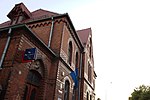Piława Górna
Piława Górna | |
|---|---|
 | |
 Flag  Coat of arms | |
 Piława Górna | |
| Coordinates: 50°41′N 16°45′E / 50.683°N 16.750°E | |
| Country | |
| Voivodeship | |
| County | Dzierżoniów |
| Gmina | Piława Górna (urban gmina) |
| Town rights | 1962 |
| Government | |
| • Mayor | Krzysztof Chudyk |
| Area | |
| • Total | 20.93 km2 (8.08 sq mi) |
| Population (2019-06-30[1]) | |
| • Total | 6,412 |
| • Density | 310/km2 (790/sq mi) |
| Time zone | UTC+1 (CET) |
| • Summer (DST) | UTC+2 (CEST) |
| Area code(s) | +48 74 |
| License plates | DDZ |
| Website | http://www.pilawagorna.pl |
Piława Górna [pʲiˈwava ˈɡurna] (German: before 1928: Ober-Peilau, then Gnadenfrei) is a town in Dzierżoniów County, Lower Silesian Voivodeship, in south-western Poland, in the western part of the hills. It lies approximately 15 kilometres (9 mi) east of Dzierżoniów, and 54 kilometres (34 mi) south of the regional capital Wrocław.
According to official figures for 2019, the town has a population of 6,412.
From 1975 to 1998 Piława Górna was in Wałbrzych Voivodeship.
History[]
The oldest historic mention of Piława Górna comes from the 12th century under the Latin name Pilava Superius.[2] Piława Górna was part of Piast-ruled Poland. Then the city came under the suzerainty of the Kingdom of Bohemia, Hungary, again Bohemia and the Habsburg Monarchy. It was an agricultural village in Lower Silesia.

After its annexation by the Kingdom of Prussia from Austria in the First Silesian War, German settlers developed a clothing industry in the village in 1743. A settlement congregation of the Moravian Brethren was built in Upper Peilau, i.e. Piława Górna, on the estate of the Austrian noble Ernst Julius, Count von Seydlitz. Imprisoned for his Protestant faith by the Habsburg rulers of Silesia, when he was freed following the Prussian seizure of Silesia, he named the new settlement Gnadenfrei ("freed by [God's] Grace") to commemorate the event. Later on Gnadenfrei would be merged with Piława Górna. From 1871 to 1945 Peilau/Piława was part of Germany. It was for many years "the longest village in Germany", stretching for several miles along the Piława/Peila stream.
By the beginning of the 20th century the village was almost completely German in ethnicity and Protestant in confession. In 1945 after World War II, it was transferred from Germany to Poland. Its German population was expelled and replaced with Roman Catholic Poles, themselves having been expelled from the Lwów (Lviv) region (now in Ukraine).
In 1962 Piława Górna was granted town privileges.
Sights[]
Architectural sights include: the Saint Martin church (built in the 16th–19th centuries), an 18th-century palace complex[2] and the Educational Centre building from the 19th century.
Economy[]
Weaving mills and quarries were located in the vicinity of Piława Górna by the 14th century; the former state textile firm and quarry still exists in the town. In 2002 Piława Górna had 120 stone-working businesses, 27 textile businesses of various kinds, 172 trade companies, and 157 service industries. The agricultural industry is based on local farming and consists of 115 small businesses which mostly grow sugar beets, rapeseed, and grains.
In order to promote tourism in the region, Piława Górna engages in agritourism.
Twin towns – sister cities[]
Piława Górna is twinned with:[3]
Gallery[]

Educational Centre

Monument commemorating Poles deported to Siberia

Post office

Palace
References[]
- ^ "Population. Size and structure and vital statistics in Poland by territorial division in 2019. As of 30th June". stat.gov.pl. Statistics Poland. 2019-10-15. Retrieved 2020-02-14.
- ^ Jump up to: a b "Historia Miasta". Urząd Miasta Piława Górna (in Polish). Retrieved August 12, 2019.
- ^ "Zagraniczni Partnerzy". pilawagorna.pl (in Polish). Piława Górna. Retrieved 2020-02-28.
External links[]
| Wikimedia Commons has media related to Piława Górna. |
- Municipal website (in Polish)
- Cities and towns in Lower Silesian Voivodeship
- Dzierżoniów County






